Subjects
.gif) |
In the field of biomolecular science, ügchiralityüh is one of the most important properties.
All of the biological molecules are alternative enantiomers which show optical activity.
An evolutionary origin of such a homo-chirality of biomolecules is still one of the mysteries of nature.
So far, the optical activities have been evaluated by the methods in macroscopic scale such as circular dichroism and optical rotation dispersion.
For clarifying causality between the optical activities and atomic/electronic configurations, it is quite attractive to investigate the optical properties of chiral molecules at nanoscale.
In this group, we began with a construction of combined analysis system for evaluating various properties of a chiral molecular nano-systems, and then proceed mainly to observe the right and left circularly polarized light emission distinctively from them using scanning tunneling microscopy light emission spectroscopy, tip-enhanced Raman scattering spectroscopy, and so on.
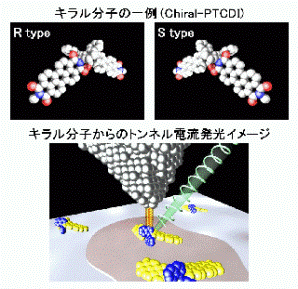
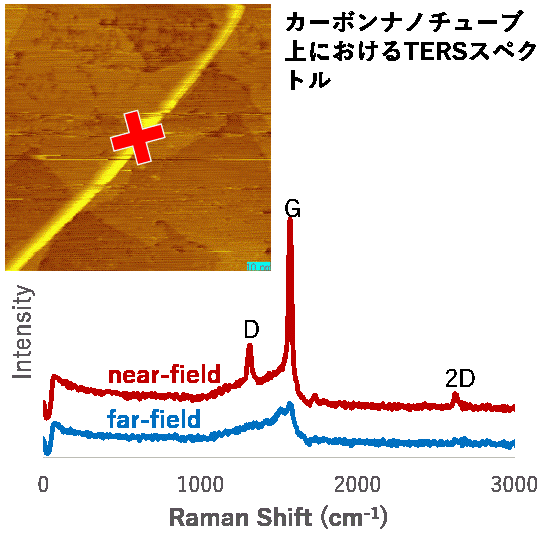
|
Accelerated electrons or positrons with several GeV generate X-rays to tangential direction, called "synchrotron radiation (SR)" having a wide range of wavelengths, high intensity and low emittance.
Using SR as a probe, we can evaluate physical properties and functions of various materials at the atomic scale.
Our group have used SPring-8, a large SR facility, and developed the experimental method that can observe the density of states caused by inner nuclear excitation in real space and atomic resolution.
We succeeded in the nanoscale elements identification in Ge / Si (111), Co / Au (111), Cu / Ge (111), and clarify principles of elemental contrasts and directly observe the atomic motion due to X-ray irradiation.
Furthermore, we develop and evaluate a general-purpose X-ray source that has minute-spot and high-intensity, and perform various measurements in a laboratory system.
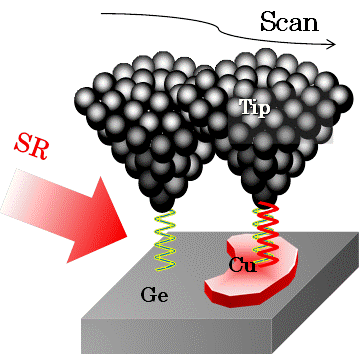
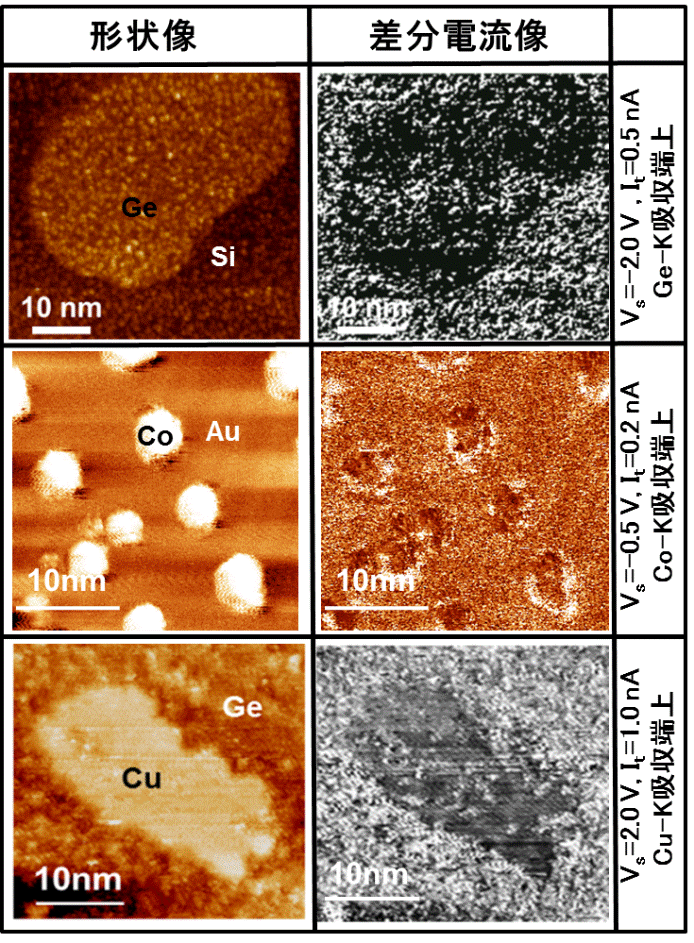
|
| Analyzing and understanding the electronic properties of single molecule is a scientifically and technologically important research theme. Nanogap research group aims to develop electronic devices by utilizing molecular properties. This group is currently developing the state-of-the-art devices that utilize the fluctuation of molecules, such as sensing device that is able to detect only one molecule in the room-temperature atmosphere, as well as the utilization of noise generated by the molecules in the detection of weak signal. The physical properties of molecules and atoms are constantly fluctuating probabilistically under any circumstances, just as the biologistsüf belief: "the source of life is fluctuation". As an example, it is expected that there will be some possibilities to develop a mechanism that can be used for information computation with the effective use of the "fluctuation" of an organismüfs brain function. In this research group, carbon nanotube (CNT) has been focused as a specific material of interest. CNT is a type of low-dimensional nanomaterial with high surface sensitivity and typical diameter of about 1 nm. Therefore, field-effect transistor (FET) consisting of semiconducting CNT bridging between electrodes with separation gap few thousand times larger than CNTüfs diameter, is extremely sensitive to the surrounding environment. Recently, nanogap research group discovered that the electronic fluctuation of the adsorbed molecules appears as a large fluctuation in the current of the FET device when redox-active molecules adsorbed to the surface of the device. In the case of single molecular adsorption, the phenomenon in which the current of the device undergoes random transition between two states (Fig. 1) has been observed. This randomly appearing two-state transition is directly related to the redox state transition of the single adsorbed molecule. On the other hand, it has been revealed that this phenomenon provides information on the redox state specific to the molecule involved, and this is considered promising as single molecular sensor which can be used in room temperature condition. From here, nanogap research group fabricated the "stochastic resonance device" (Fig. 2) that actively utilizes the "noise" generated by these molecules. Stochastic resonance is a phenomenon in which a weak signal that is originally below the detection limit threshold is enhanced by noise (noise fluctuation), which eventually becomes detectable or responsive. It is expected that such signal detection utilizing noise fluctuation can be used as one of the low-power-consumption-driven systems. As described above, through research aiming at the expression of biological function (in particular, brain function) using molecular materials, it is possible to realize a future "molecular neuromorphic system" that can learn and grow on its own. | 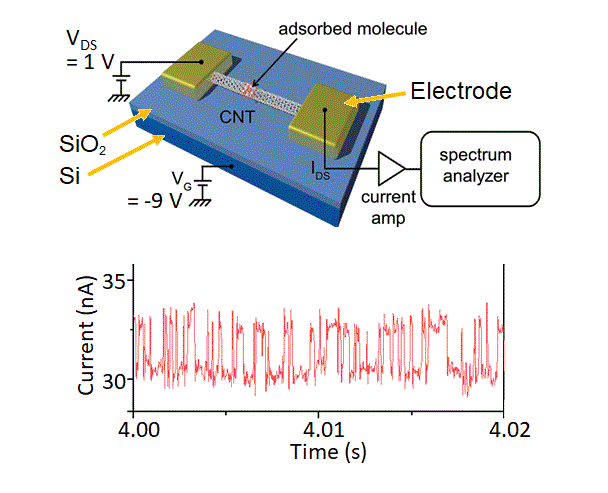
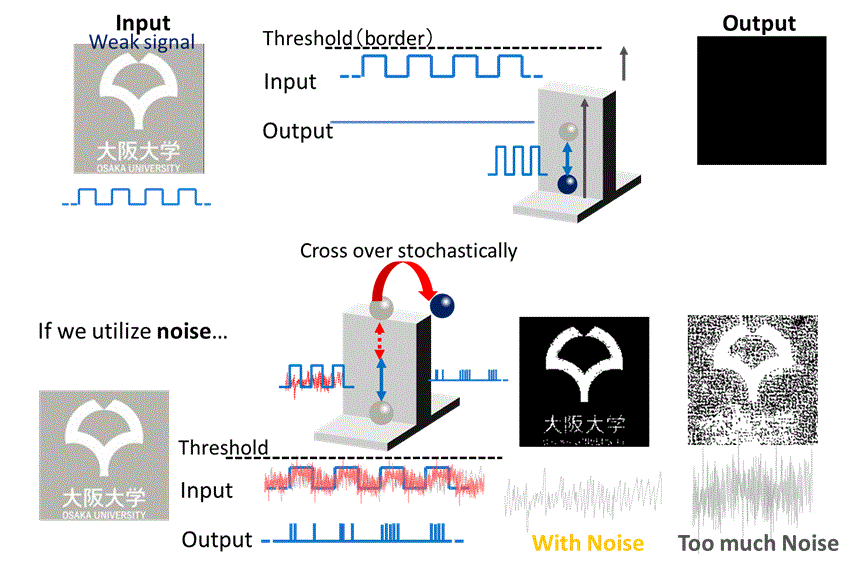
|
Recently, not a day passes without hearing a word ügartificial intelligence: AIüh.
The AI is now everywhere and becoming indispensable in our life.
Even non-scientists can start to use deep learning for solutions to various social problems.
The neural network performs in current computing hardware based on CMOS, such as Central Processing Unit: CPU and Graphic Processing Unit: GPU, however, it is power-hungry and time-consuming.
Therefore, development of custom-designed AI hardware consisting of emerging devices and materials has attracted much attention.
Reservoir computing is one of machine learning frameworks for recurrent neural networks proposed recently, utilizing a signal response similar to physical dynamics with nonlinearity, so that any physical phenomena satisfying its requirement can be used for the computing.
We are pushing reservoir computing to deliver radical improvement over the next stage, with innovation and co-development of hardware implementation from nanomaterials to electronics.
Reservoir computing effectively capitalizes on features such as nonlinear transformation and short-term memory.
Organic materials and nanomaterials often possess characteristics of fluctuations, nonlinear response and slow reaction-time-constants etc. that might be valuable for reservoir computing.
We hope that promising AI hardware comes into ordinary service in the future.
.gif)
|
| In the brain of an organism, innumerable neurons connect with each other through synaptic connections to form a network, thereby performing advanced information processing. An artificial neural network, which is an information processing method that imitates that of brain, has greatly contributed to the development of artificial intelligence (AI) technology. In recent years, it has reached to the extent that it is applied in the field of image recognition, natural language processing and other various tasks in our society. Nowadays, there is no day without hearing the word of ügAIüh. However, current AI implements a neural network which is capable of processing a large amount of information in parallel on a von Neumann type computer, and have problems in terms of power consumption and information processing speed. Therefore, development of hardware dedicated to neural network is strongly required to perform the computation efficiently. Our group focused on the strange phenomenon that PEDOT:PSS, one of the most well-known conductive polymers, is polymerized to form wires by electrolytic polymerization, and tried to fabricate neural network hardware through the use of function of PEDOT:PSS wire growth as a nonvolatile electrical resistance-change-element. We successfully accomplished a learning on un autoencoder neural network consisting of PEDOT:PSS wires, which realizes feature extraction of three 3ü~3 binary 9-pixel letters encoding to 3-pixel information. At present, our group is working on more complex and advanced information processing toward practical use, as well as establishing wiring technology. In the future, we would like to make highly integrated devices by applying 3D polymer wiring technology. Since there are still many mysterious points in the growth principle of the wire, we are working to pursue the growth mechanisms. We conduct research believing that conductive polymers that can freely connect spaces will greatly contribute to AI technology in the near future. | 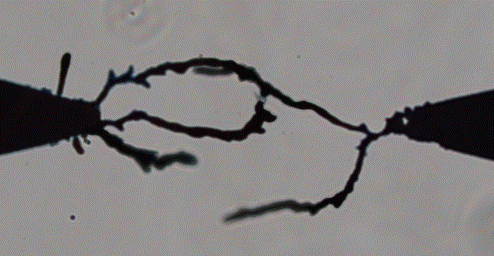
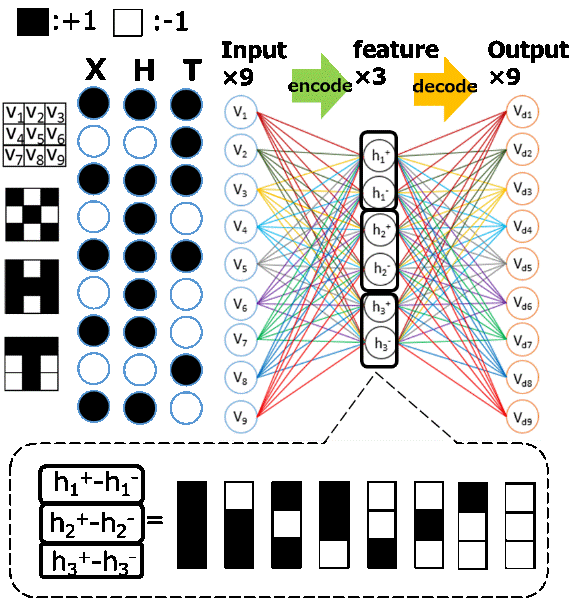
|
| Recently, biomimetics, a research field that mimics and reproduces superior functions of organisms, has become popular. In particular, structural colors, caused by the interaction between tiny nano-structures and light, present vivid hue (e.g. beetles, peacocks, and Morpho butterflies), which is distinct from pigment coloration. Morpho butterflies in South America (Fig. (a)) are well known for their wingsüf brilliant blue color, and its coloration is independent of viewing angles in spite of the interference color. This contradicting feature originates from the skillful combination of nanoscale üeorderüf and üedisorder.üf We have demonstrated the principles by artificially reproducing the nano-structure with üeorderüf and üedisorderüf (Fig. (b)). The fabricated Morpho reflector shows the broad-angle, bright blue color and no color fading, and is environmentally friendly due to unnecessity of pigment, which can be applied to the visual industry such as ornament, cosmetics, and displays. Nowadays, in addition to optical simulations on the üedisorderüf and development of large-area, fast-fabrication technologies (Fig. (c)), we are working on new applications and mimicry of other organisms. | .gif) üúBack to top üúBack to top
|